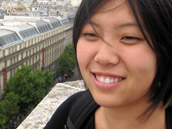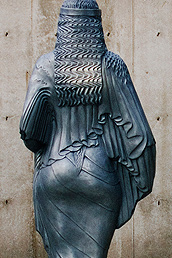Non-Fiction Review
Rosel Kim
Adult Child of Hippies
by Willow Yamauchi
London, ON: Insomniac Press, 2010
297 pp. $16.95
On the cover of Willow Yamauchi’s book, Adult Child of Hippies, a young girl – who is naked except for a flower-patterned scarf draped on her head – stands with her eyes closed as if in a trance with a flower in her mouth. But a hippie childhood wasn’t all fun and games as outsiders may assume. Throughout the book, the reader learns that life with hippie parents is a paradoxical existence of paranoia and danger, stemming from a staunch commitment to freedom and love.
The book is a combination of family photographs from the author and the other adult children of hippies, as well as one-sentence description of life in the commune that accompanies each photograph. It’s set up as a survey for the reader, with the lead-in “You know you are an adult child of hippies if….” with a check-box after each description, so the reader can discover if s/he also qualifies as an adult child of hippies. Many of the criteria proposed by Yamauchi are humorous and tongue-in-cheek. My favourite spread included the caption, “[y]ou know you are an adult child of hippies if you slaughtered your own pigs. Bonus point: You used the tail to grease your frying pan.” (34) The photo on the opposite page shows the bottom half of a slaughtered pig hanging on a tree, surrounded by bearded men who appear excited. Later on, a naked man sitting on a tiny basin that barely fits his buttocks smiles at the camera, with the accompanying caption: “You bathed in small basins to conserve water” (244). But not all photo-description pairings are as well-matched, or effective. One description “You thought all loaves of bread weighed over 5 pounds” is not accompanied by a photo of an impressively dense loaf of bread, but a close-up of a baby’s face instead.
Contrary to stereotypical expectations, Yamauchi’s depiction of children of hippies is not all idylls and innocence. Some factoids are harmless and cute (“You could ‘downward dog’ before you could walk” p. 198), while others appear more questionable (“Your parents felt that power tools were an appropriate plaything” p. 276). Generally speaking, life on the commune strangely robs “real” childhood by imposing knowledge of sexuality (“You could clearly understand the differences between ‘open relationship,’ ‘an understanding,’ and ‘swinging’.” p. 232), drugs (“You collected pretty LSD blotters instead of stickers” p. 186), and the government’s restrictive ways.
Yamauchi provides an intriguing introduction to the aftermath of rebellious years experienced by those who did not consent to it in the first place. The book certainly sparks a curiosity in the reader, but it fails to satisfy it completely. While it provides a window for readers to peek into the children of hippies’ lives, that window seems too grainy with not enough contextualization to provide a dynamic picture. It’s a shame that the photos in the book are black and white – some of the details of the pictures are lost and flattened in shades of grey. I also couldn’t help but want more detailed and chronological account of how one exactly transitions from being a child of hippies to adult child of hippies.
Nevertheless, Yamauchi manages to delve into an oft-neglected identity category of those who did not choose an alternative lifestyle, but were forced to live it and embrace it. By positing that those who experienced “extreme” hippie lifestyle of their parents all turn out to be the most straight-laced adults, Yamauchi also questions the value of staunch granola lifestyle by concluding that hippie lifestyle bred more obedient citizens in its offspring. It would be worthwhile to see follow-up – either from the author herself or other adult children of hippies – that explores the subject further.




